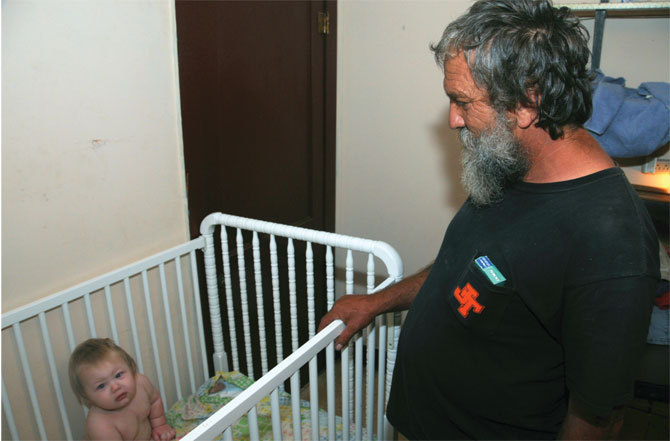Jacob Holdt is one of America’s most important photographers and he’s not even American. His book American Pictures did as much to revolutionize documentary photography as it did to paint an entirely new image of the country in the 70s, so it’s at least a little fair that Americans stuck their flag in him. In truth, he’s a Dane.
As the American Pictures story goes, Holdt, facing multiple criminal charges after some nefarious left-wing activities during the late 60s, left Denmark intent on joining one of Latin America’s various guerrilla movements. He got sidetracked, hitching some 80,000 miles back and forth across America and bedding down with gangsters, junkies, prostitutes, and Klan members. His parents, wary of the outrageous letters he sent from the road, sent him a $30 Canon Dial half-frame camera to document it all. Five years later he’d taken nearly 15,000 of the country’s most indelible photographs.
Holdt still travels the States visiting with his subjects. He’s even brought his two-year-old son on trips through urban ghettos and rural slums to make sure he didn’t become a racist prick. This is not at all unexpected from a guy who funneled all the profits from his book toward the anti-apartheid struggle in Africa and says the best way to deal with the odd gay rape is to instantly embrace your attacker. In addition to the enlightening little chat that follows, Holdt was kind enough to share some new photographs he took of a mass-murderer named Dave hanging around with his family.
Vice: Can you tell us a bit about these new images?
Jacob Holdt: I met Dave in ’96 through his brother, Snoopy, whom I’d picked up in my car back in ’91. I’d given up hitchhiking by then since no one would pick you up anymore. Snoopy had been waiting on a ride for three days when I came along. When he eventually started talking, he told me his brother and him had killed more people than he could even count. Naturally, I was skeptical and just dropped him off where he needed to go.
Had he actually killed anyone?
I didn’t know at that point, but five years later I tracked him down—me and a journalist, who was intrigued by this random mass-murderer story. Snoopy was in prison. Apparently, two days after I had dropped him off, he had broken into a house and tried to butcher the family living there, cutting up the woman’s stomach. She barely survived. There was no reason to doubt him and his brother having murdered all those people.
And that motivated you to track down his brother, Dave.
I was curious about where all that hate comes from and what makes people act in such desperation. Dave and his family lived in the middle of a deserted swampland and everyone was afraid of them.
Were they friendly with you, though?
At first we were met with shotguns pointed at us, but you have to understand that people like that are potentially the easiest to befriend because of their hunger for love and acceptance. Obviously, me knowing Snoopy smoothed the waters. I watched Dave and his wife, Connie, smack each other around and beat on their kids. Getting actively in between them wouldn’t have helped anything. I mean, I wouldn’t get very far if I was perpetually criticizing people in their own homes. I just hang around and observe and help where I can. By doing that, you can enable people to believe in themselves. Dave and Snoopy probably didn’t kill people because they hated them, more likely they did it because they hated themselves.
And then in May of last year you went back to visit.
Yep. I brought a friend with me, and when I told her we were going to see a mass murderer she thought I was joking. When we arrived at Dave’s, the front lawn was covered in blood. I thought, “Oh no, oh no.” But it turned out to be blood from his cow.
He’d killed it?
Yes. He told me he’d been drunk the previous night and used his cow as target practice. As it was trying to escape he got his shotgun, started up his old pickup truck, went after it, and eventually killed it.
You’re practically laughing!
What else can you do? The spiral of violence, hate, and despair had run so deep in this family. You see that photo of Dave’s daughter Mel? She’s looking at a photo I took of her uncle Snoopy back in ’91. When he got out of prison in 2003, he raped her—his own niece. Today she’s in prison.
It’s a pretty horrid situation.
Well, I’m dogmatic in my choices—if I wasn’t I would always have chosen beauty over ugliness, pleasure over pain. You know how hippies always say, “Let’s have a good time”? To me that’s just selfish, and thinking like that would have gotten me nowhere. I would have never made American Pictures without being used—and without the abuse I endured.

Snoopy, Dave’s brother, after hitching a ride with Holdt in ’91.
Videos by VICE
How did American Pictures come about? I mean, you were going to be a revolutionary freedom fighter.
I started hitchhiking to various Vietnam rallies across America instead. In Chicago I met an 18-year-old black girl who let me stay with her family in an all-black neighborhood. Seeing firsthand how alienated the black community felt was just mind-blowing to me.
But you hadn’t started taking pictures at that point?
No, my parents sent me the camera in ’72, and at first it was just a faster way for me to keep a journal. I had no photography experience, and whenever I showed my pictures to real photographers they would shake their heads at me. But they also gave me some tips, like wrapping pink toilet paper around the flash and placing it behind lamps… stuff like that.
When did you realize you were actually in the midst of a massive photographic project?
Mostly I just thought about getting by and finding places to stay. But in ’73 I saw a juxtaposed photo slide show in Florida and I thought that this could be a way for me to present my photos and explain the stories behind them. I still don’t think my photos have stand-alone qualities to them.
A lot of people are protective of your work, though, and believe you’re a very skilled photographer.
But I’m not a photographer—no more than anyone else with a camera. I barely took a single picture for 12 years after American Pictures. My talent was gaining access to people’s homes and lives. Once I was there I basically just had to point and shoot. People often send me their photos of homeless people on the street, but truthfully, they bore me. Anyone could take those pictures.
Why do you think getting this sort of access came so easy to you?
It didn’t, not at first. I spent two years being mugged whenever I entered black neighborhoods. So I mostly stuck to college towns. I met black students and gradually it changed my outlook, because I also met their friends and relatives and occasionally they would be ghetto thugs.
So what changed exactly?
Simple: I stopped being a racist. I had been fearful of them, because I was told “Don’t go there” or “Be careful in that neighborhood.” When you are fearful like that you perpetuate a negative prejudice. You are telling people that they are bad and you have reason to fear them. That’s the psychology of racism, and that’s what I try to dismantle when I talk about American Pictures today.
That can’t be as easy as it sounds.
It doesn’t happen overnight, but when you give out acceptance you should receive it as well. After those two years I was never mugged again, no matter where I went. But you still have to prove yourself. Every time I arrived in a new city and ghetto, they automatically called me “boss man” because they thought I was an undercover cop. You know, everyone had long hair back then, especially undercover cops. But then I started weaving my beard and that really opened doors for me.
That’s all it took?
It also closed some. Like when I had to renew my visa I would always go to either Mexico or Canada because it was free there and I couldn’t afford the ten bucks it cost in the US. The trouble was getting back in, looking like a hippie during the Nixon administration, so I had to improvise. In Canada I had some friends who would lend me their Cadillac. I filled it up with Bibles and posed as a Bible salesman. I also had a short-haired wig for emergencies.
Smart. But how were you able to afford to buy and develop your film?
I donated blood once a week—that earned me two rolls. When I was through with them I sent them to a girlfriend in Washington and she would stock them. I went there once a month to develop them and look them over, but she wasn’t happy with our arrangement, and she kept pushing for me to marry her. Eventually I got scared she would destroy the film if I kept leading her on, so I moved them to a more levelheaded ex-girlfriend’s in New York.
You had lots of girlfriends back then?
When you travel like I did, you didn’t get to choose. That’s why I called myself a vagabond. It’s a different philosophy.
How so?
Well, a hitchhiker travels from A to B, whereas a vagabond moves in a third dimension—you roll with the punches. I realized early on that if I allowed myself to choose, I would never get where I wanted to go: beyond and behind the scenes.
So it wasn’t a case of just catting around the country.
It wasn’t desensitized like that. I received tons of love from them and vice versa. It kept me going. But of course beggars can’t be choosers, so it wasn’t like I always loved the company of each and every woman I met. But I couldn’t say no, and that applied to men as well.
Really?
Yes. Every so often I would hitch rides with dirty old men, as I call them. I wasn’t gay, but I guess I just felt bad for them and at the same time I was fascinated by the amount of self-loathing they exhumed, the mechanisms of it all. But as a whole, the things I experienced and saw were amazing. I was having the time of my life, and people need to understand that when they see my pictures.
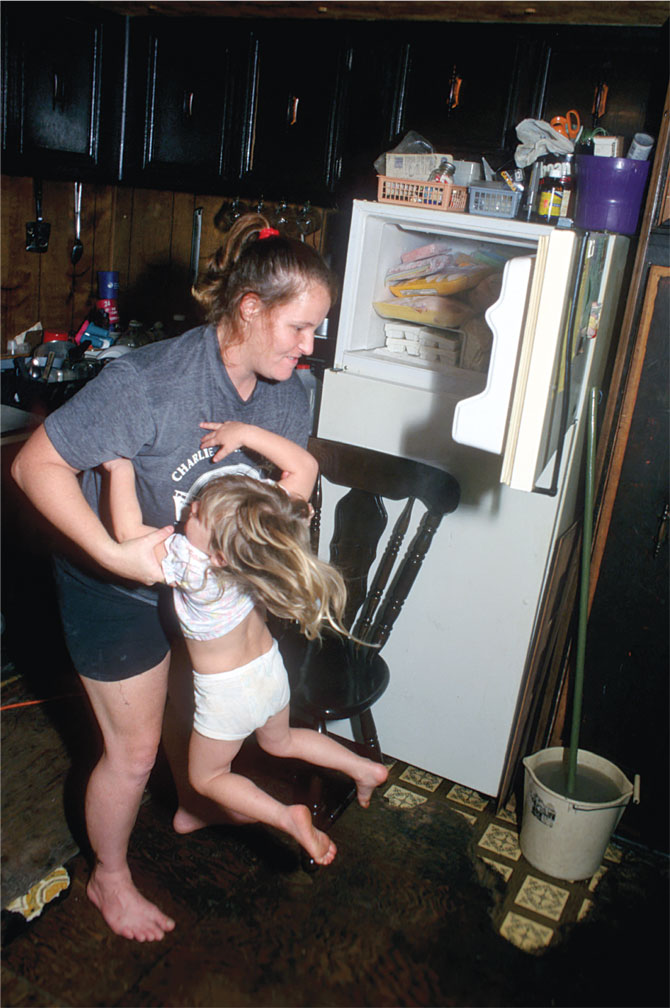
Dave’s wife, Connie, disciplining their daughter Mel at their house in ’96.
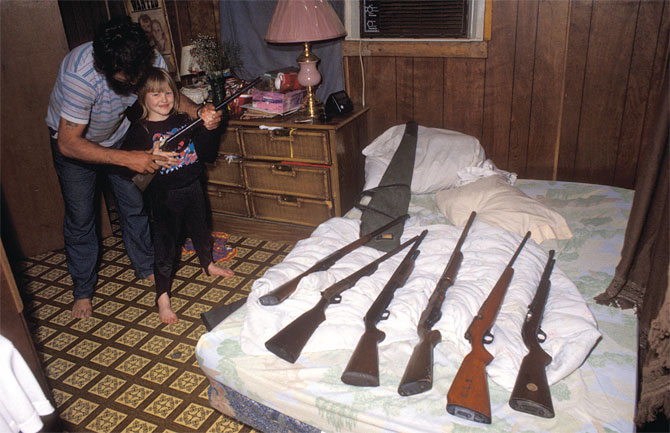
Dave showing his oldest daughter Mary how to fire a rifle in ’96.
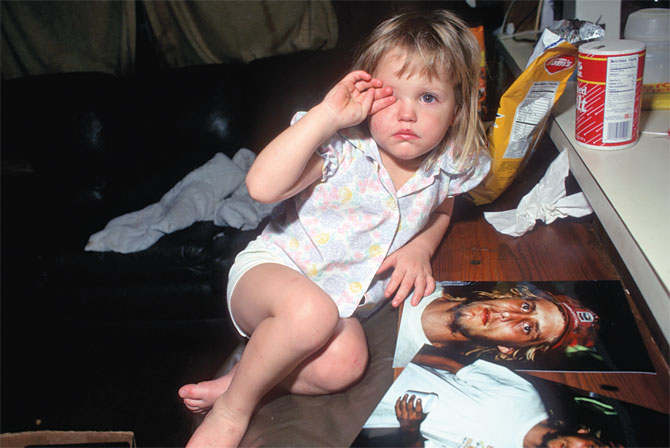
Mel with a picture of her uncle Snoopy in ’96.
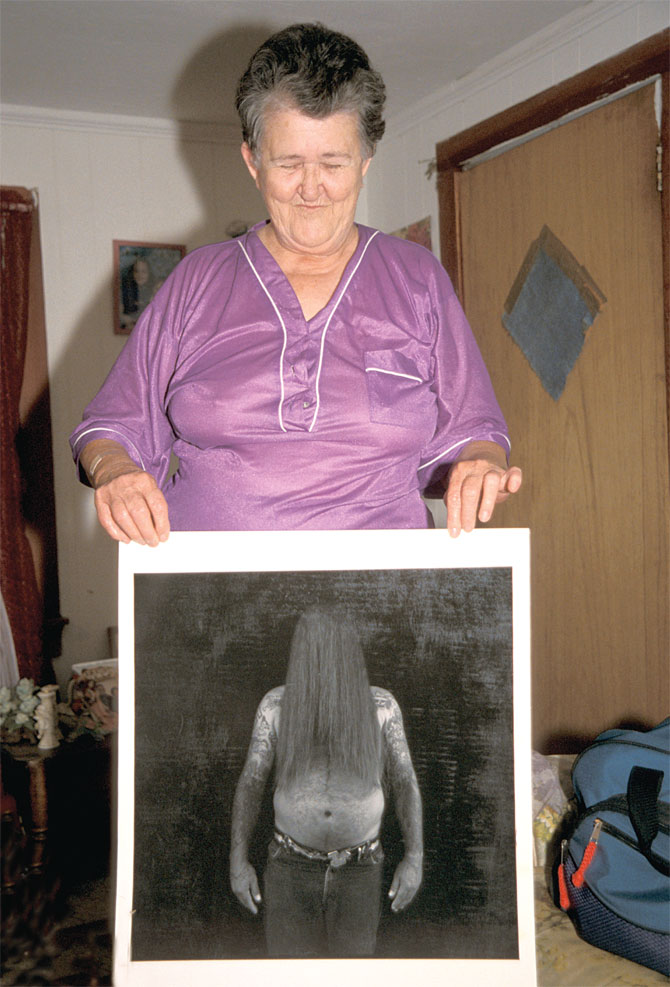
Dave’s mom in ’96 with a picture of her third son, who is currently serving a life sentence.
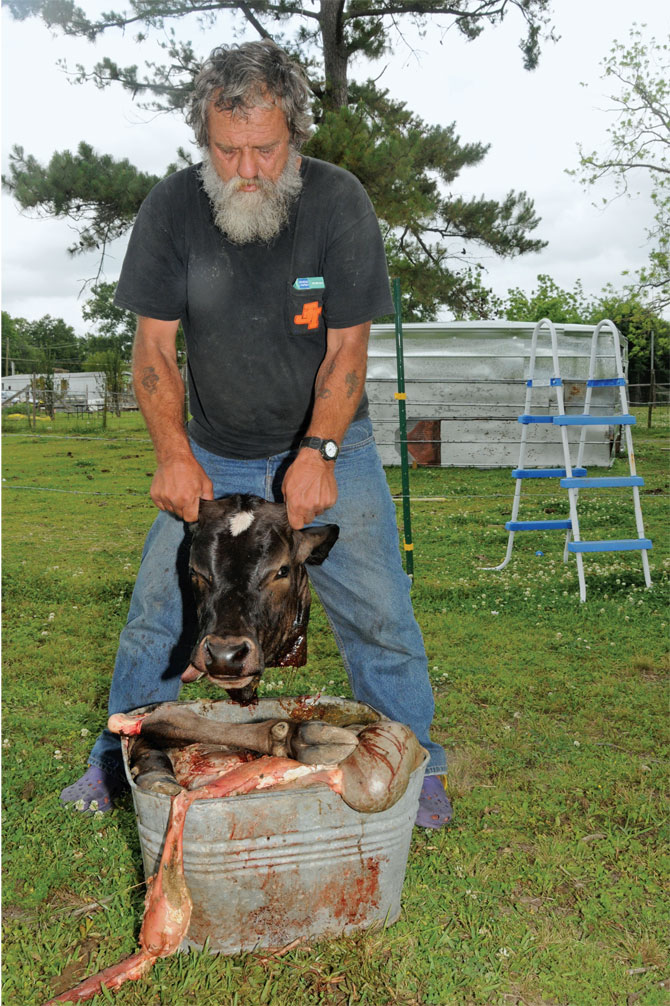
Dave with his cow, which he killed the night before, in ’09.
Dave with the youngest of two babies his daughter Mary left behind, in ’09.
More
From VICE
-

Screenshots: Bethesda Softworks -

Screenshot: Sony Computer Entertainment -

Screenshot: WWE -

Screenshot: Bandai Namco Entertainment Inc.

